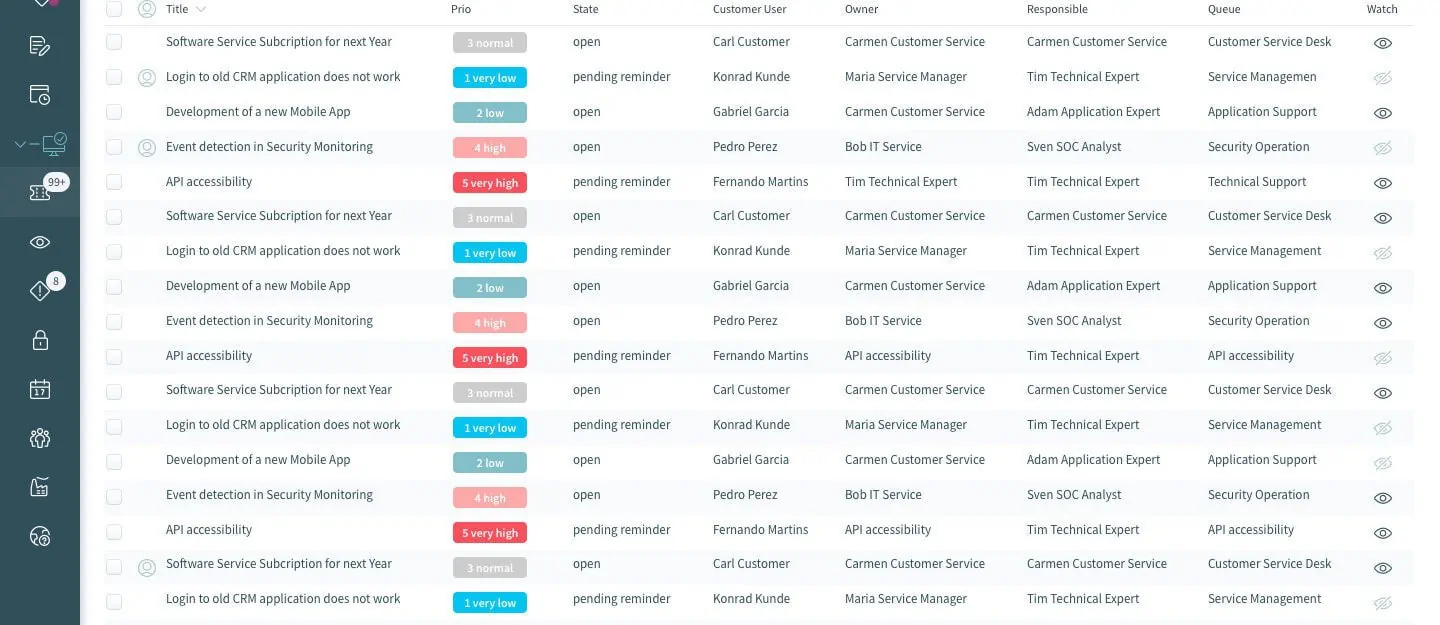

In 2019, when we started to look intensively at the new technologies that are now present in OTRS 8, we did this to get existing incompatibilities and limitations out of the way for our customers. Specifically, there are about 70 Feature Add-Ons for OTRS. In version 6 and also in the ((OTRS)) Community Edition, 28 of these could not be used simultaneously. This meant that some important or often-needed feature addons were partly incompatible with each other.
This was a problem when we wanted to develop solutions in joint workshops with the customer. The consequences were mostly compromises and costly alternatives. With OTRS 8, the flexibility and customization that customers got resolved nearly all of these issues.
The effort to create a completely new interface for the customer and agent was, of course, not small; but the time and effort spent by our developers meant that many problems and restrictions simply disappeared into thin air.
In my own usage of OTRS 8 and in my work with our customers, these are some of the highlights that I’ve observed in the past year:
Flexible Forms Simplify Creating and Editing of Business Objects
In previous OTRS versions, process forms were not dynamic or did not adapt to the inputs already made. The position of the fields in the standard actions, such as “New phone ticket” or “New appointment,” were rigid and not changeable. Both in the design and in the use of the forms in older versions, much more time had to be spent. This is a thing of the past with OTRS 8: Today forms and input masks can be extended as desired and can even look different from one person to the next, depending on roles and permissions.
Interesting use cases can be mapped, even independently at the agent level.
Organizer Items Become Your Personal Monitoring Tool
Further advantages are offered by the new organizer items in OTRS 8. Instead of starting search templates daily to check for search results, an organizer item can be created. This visually shows the number of business objects found. By the way, it is not limited to tickets.
This allows interesting use cases to be mapped, even independently at the agent level. (Previously, there would only have been a solution with the help of individual programming.) Some examples include:
- A list of devices for which maintenance is due soon or a license is about to expire,
- Devices that currently have the status “malfunction,”
- A list of all open tickets,
- Tickets older than 3 months, or
- Tickets of my most important customers.
Modern Dashboards Match Your Unique Needs
Hard to beat for flexibility are the widgets in OTRS 8: I can now add as many widgets as I want to my personal dashboard. Each can be named, filtered and designed differently. For instance, a widget can be:
- A constantly updating report in the dashboard
- Open requests and incidents that I have recently worked on
- Customers from a region or a responsible salesperson
- The information most important to me on the ticket
- A separate communication history filtered to internal communications
As if that wasn’t enough, widgets can be distributed across multiple dashboards and positioned differently.
My consulting team, for example, uses layout one to display only their own future appointments and switches to layout two as needed to get an overview of the entire team and their appointments. As the person responsible for the consulting resources, I created several calendar widgets, each showing a workload per consultant and subsidiary. Gone are the days when I had to adjust my filters 15 times a day.
And, thanks to the latest technology, OTRS 8 offers PulseMode. This means that I get changes in near real time, without delay, and I can react to them directly.
It's exciting when new solution possibilities arise that we had not thought of before.
Device Data and Other Objects Accessible in the Customer Interface
The self-service portal does not only include knowledge base articles (FAQs) and open requests, but it also displays an overview of the equipment to which I have access. As an employee, my requests or problems are usually related to my equipment, so being able to select the affected device is not only necessary, but also saves time in the analysis. The determination of contract-relevant information, such as an SLA, can then be done automatically. Or, as an end customer of a service provider, I may want to see the machines of my company, the linked maintenance contract or recently occurred malfunctions.
In Conclusion
It’s exciting when new solution possibilities arise that we had not thought of before. As we work with customers, we uncover more and more use cases for the increased functionality and flexibility of OTRS 8. There is no denying it: OTRS 8 offers many new tools, to my consulting team and to every OTRS administrator. Its limits are extended every day.
This is exactly why we offer test systems, transition, admin trainings and review & optimization workshops. We want our customers to benefit from our experience and to prepare for the version change in the best possible way.
Categories
- About OTRS Group (21)
- Automation (3)
- Corporate Security (26)
- Customer Service (31)
- Developing a Corporate Culture (12)
- Digital Transformation (53)
- General (79)
- ITSM (31)
- Leadership (22)
- OTRS in Action (8)
- Processes (5)
- Using OTRS (14)
